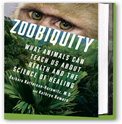This is very interesting on how we can learn about health through the animals, to include our dogs, cats and wild animals. T his cardiologist from UCLA wrote a book to document her findings and explorations. (give this some thought next time you see UCLA Medical Center given a “C” on those data flawed rating sites:) So who’s to blame for our fat dogs and cats? Well we are if we over feed them as they are dependent upon us but they get a lot of other types of chronic and non chronic care diseases too. The video here is fascinating on what the doctor found. Now I would never recognize an obese dragonfly nor would I ever think about a “goose” suffering from depression but I’m sure ducks are in there too:)
his cardiologist from UCLA wrote a book to document her findings and explorations. (give this some thought next time you see UCLA Medical Center given a “C” on those data flawed rating sites:) So who’s to blame for our fat dogs and cats? Well we are if we over feed them as they are dependent upon us but they get a lot of other types of chronic and non chronic care diseases too. The video here is fascinating on what the doctor found. Now I would never recognize an obese dragonfly nor would I ever think about a “goose” suffering from depression but I’m sure ducks are in there too:)
You can visit the website for the book and see more, including this video with showing how animals behave in the wild and their addiction that develop with finding fields of pot, or berries that have fermented and they are driven and addicted to such. We had a case in California to where a flock of birds got high on fermented berries and all flew into glass and killed themselves as they were “drunk”. As is pointed out they don’t have the constant access that we do with buying off the shelf. Wild animals are getting fatter too she points out. Cows and goats seem to be less affected in some areas. The doctor said she became a better doctor after working with veterinarians. Horses she said have sexual performance problems too, so if you are a man you and the stallions may have some common issues:)
From the past with a former pet, who had two major back surgeries I can certainly add that some of the care centers do have veterinarians that specialize in oncology, orthopedics and more and it’s not cheap but they are there and gave my former dog many extra years of life.
From the website for Clinicians and Scientists
For individuals struggling with, clinicians treating, or investigators studying patients with alcohol and drug abuse “Zoophoria” exposes  substance seeking in wild and domestic animals and offers species-spanning therapeutic insights. Readers interested in human behavioral disturbances may find “Grooming Gone Wild” of interest as it identifies natural animal models of self-injury (cutting) in animals or “Fear of Feeding” which identifies natural animal models of anorexia nervosa and bulimia nervosa.
substance seeking in wild and domestic animals and offers species-spanning therapeutic insights. Readers interested in human behavioral disturbances may find “Grooming Gone Wild” of interest as it identifies natural animal models of self-injury (cutting) in animals or “Fear of Feeding” which identifies natural animal models of anorexia nervosa and bulimia nervosa.
“Leaving the Nest” compares adolescents across the animal kingdom revealing a remarkable increase in risk-taking (and increased risk of accidental death) across adolescents of many species. “Fat Planet” points out parallel epidemics of obesity in human and non-human populations including companion animals, agricultural animals and even some species of wild animals. The chapter points to how and why animals gain weight as an unexplored source of knowledge for human obesity investigators. Finally, “Zoobiquity” features the essential role veterinarians play in keeping all of the patients on the planet safe from pandemic threats.
Dogs and cats get compulsive disorders too. I think mine has one:)
A Dog’s Work Is Never Done–My Loyal Office Assistant Crawls More Than Just the Web (Video)
Animals don’t use condoms and here’s a video talking about STDs in animals and how the Koalas are facing a crisis here with the spread of the disease, and pigs can suffer from anorexia with social stress. We also know that animals do the get the flu and bird and swine flu that has been in the news and canine flu is now a concern so who knows, perhaps our dogs will be getting vaccines for the flu too and some influenzas blend. This looks to be a very interesting book and I’ll be putting this one on my list to read. BD
Did you know that dragonflies can become obese? That koalas get Chlamydia? Or that cancer dates back to the dinosaurs?
In fact, animals suffer from a lot of the same medical maladies as humans, and these days, zoos across the country are bringing physicians in to consult with veterinarians.
In 2005, Dr. Barbara Natterson-Horowitz, a cardiologist at UCLA Medical Center became one of them when she was called to treat an unusual patient at the Los Angeles Zoo.
“I was doing cardiac ultrasound – which is imaging of the heart of a chimpanzee and some other animals,” explained Natterson–Horowitz. “And I was listening to the veterinarians talking and they talk about diabetes and obesity and cancer.”
Natterson-Horowitz thought it would be interesting to look at human diseases through the lens of veterinary medicine, so she decided to write a book based on her experiences.
“Obesity is a significant problem among cats and dogs, our companion animals – up to 40 percent of them are now overweight,” Natterson-Horowitz said. “Even sexually transmitted diseases. Koalas get chlamydia, killer whales with Hodgkin’s lymphoma. There are many, many parallels.”
